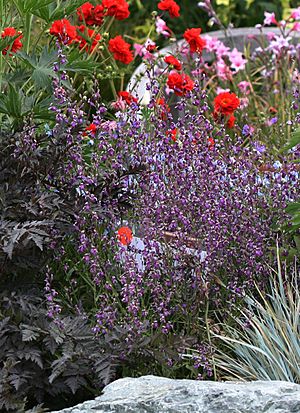Metcalf Canyon jewelflower facts for kids
Quick facts for kids Metcalf Canyon jewelflower |
|
|---|---|
 |
|
| ssp. peramoenus in a nursery | |
| Conservation status | |
| Scientific classification | |
| Genus: |
Streptanthus
|
| Species: |
albidus
|
Streptanthus albidus is a special kind of flowering plant. It belongs to the mustard family. People often call it the Metcalf Canyon jewelflower. This plant is found only in California, especially in the Central Coast Ranges and the San Francisco Bay Area. It likes to grow in open, grassy places, often in a unique type of soil called serpentine soil.
What Does the Metcalf Canyon Jewelflower Look Like?
The Metcalf Canyon jewelflower is an annual plant. This means it grows from a seed, flowers, produces seeds, and then dies all within one year. It has a straight stem that can grow up to a meter (about 3 feet) tall or even a bit taller. The stem usually has branches. Near the bottom, the stem has tiny, stiff hairs.
The leaves at the base of the plant are shaped like a spear. They have edges that look like small teeth. These leaves grow on winged stalks. Leaves higher up on the stem are smaller and thinner. They might be smooth or have slightly toothed edges.
Flowers grow along the upper part of the stem. Each flower has a cup-shaped part called a calyx. This calyx is made of sepals that are about a centimeter long. The sepals can be white or purple, depending on the plant's type. Pretty petals curve out from the top of the calyx. After the flower blooms, it produces a long, thin fruit. This fruit is called a silique and can be up to 12 centimeters (about 5 inches) long.
Different Kinds of Jewelflowers
There are two main types, or subspecies, of the Metcalf Canyon jewelflower. Both of these types are quite rare.
- The first type is ssp. albidus. This one is even rarer than the other. The United States government has listed it as an endangered species. This means it is at high risk of disappearing forever. This subspecies is found only in Santa Clara County. There are only about nine known places where it still grows. Its sepals are white or have a green tint.
- The second type is ssp. peramoenus. This one is sometimes called the most beautiful jewelflower or the uncommon jewelflower. You can find it in several spots around the Bay Area. It also grows near San Luis Obispo. This subspecies has sepals that range from pale to dark purple. Its petals are also purplish.


